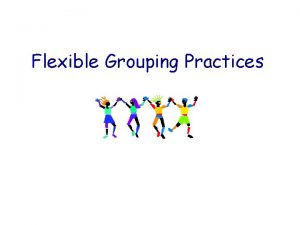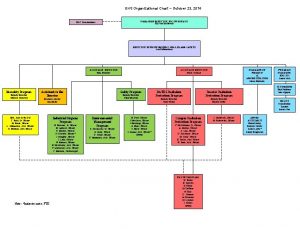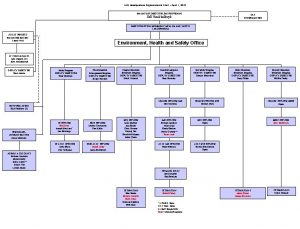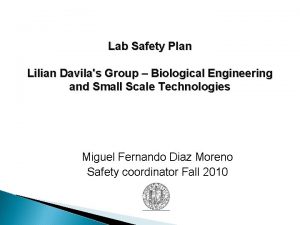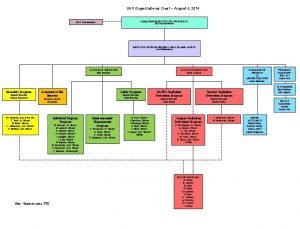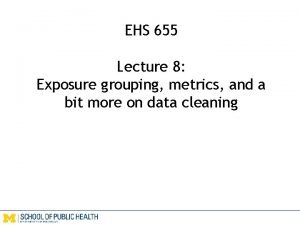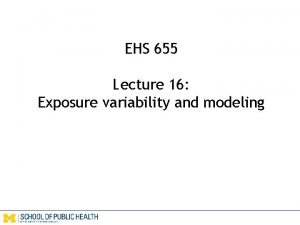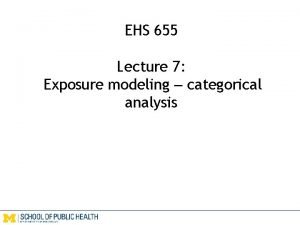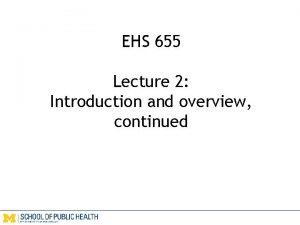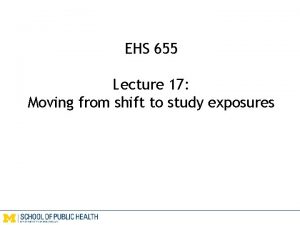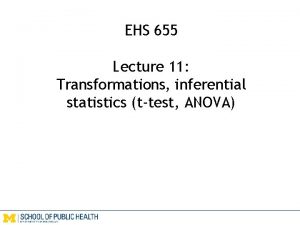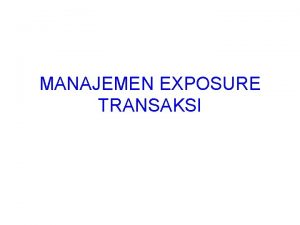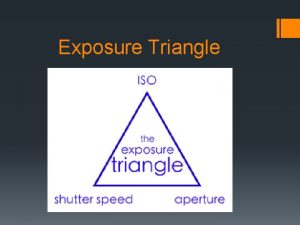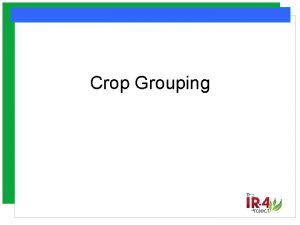EHS 655 Lecture 7 Exposure grouping strategies Exposure

































- Slides: 33

EHS 655 Lecture 7: Exposure grouping strategies

Exposure analysis in a nutshell 2

What we’ll cover today o Attenuation bias o Sampling issues and temporal trends o Exposure groups o Stata commands 3

ATTENUATION BIAS Heederik, Attfield, 2000 4

Repeated measurements Loomis, Kromhout, 2004 5

Ways to reduce attenuation bias o Increase number of exposure measurements person o Increase between-subject variability so inter-individual exposure range is larger 6

SAMPLING ISSUES o Several different sampling strategies n n Haphazard/convenience Worst case Representative Random Question: what are the strengths and weaknesses of each of these approaches? o How exposures were collected may determine what we can infer from them o Also need to consider temporal trends 7

Sampling issues - temporal trends Heederik, Attfield, 2000 8

Sampling issues – temporal trends Davies, Teschke, Kennedy, Hodgson, Demers, 2008 9

Individual-level assessment o Exposure varies greatly over time and space o Measure individuals’ exposures n n Use repeated measurements on individual to calculate individual average (only their data) Often considered gold standard approach Ignacio and Bullock, AIHA, 2006 10

Question o If individual-level approach is gold standard, come up with at least two reasons we might want to create exposure groups? 11

Reasons we might not want individuallevel assessments o Even with repeated measurements, measured average level is at best approximation of true exposure n N of repeated measurements per individual usually small (scarcity of data) o Higher within-person variability and/or smaller interperson variability = more attenuation of exposureresponse relationship o Logistical/financial challenges o Lack of direct access to individuals 12

EXPOSURE GROUPS o To address scarce individual data, we commonly pool data across individuals n Create group estimates o Increased amount of data in groups reduces random variability associated with estimate o Apply group estimates to individuals who likely have similar exposures n May not be truly applicable to all individuals in group 13

Group-level assessment o Create subgroups based on common features of exposure n n Ideally, all workers within each group measured Must consider between-group, within-individual variability Tielemans, Kupper, Kromhout, Heederik, Houba, 1998 14

Advantages of grouping o Often more effective than individual-level assessment n Especially when temporal variability large o Logistically less demanding than individual approach o Should result in almost unbiased estimated coefficients of exposure-response relationship n Attenuation very small with grouped exposure data 15

Grouping and attenuation Seixas and Sheppard, 1996 16

Exposure groups o Originally “Homogeneous exposure groups” (HEGs) o Current trend is “Similar exposure groups” (SEGs) o Groups frequently defined by common structures n n o E. g. , job title, work area, activity, behavior, agent, street, etc Individuals in different groups assumed to have different exposures Individuals within groups also have different exposures n Differences in activities, behaviors, protective equipment 17

Exposure groups o Statistical measures of central tendency often applied to groups n n o Mean, median, mode We treat every individual in the group as though they are exposed at the this measure of central tendency For categorical exposures, we assume groups are exposed (1) or unexposed (0) n Assumes zero variability in groups 18

What do we need to think about when grouping people? o Specificity n n o Summarizes variance within group Large variance = highly specific Precision n n Summarizes variance between groups Large variance = highly precise 19

Exposure grouping goals Goal 1: create groups which retain true individual differences (specificity) n i. e. , within-group variability small compared to between-group variability Goal 2: create groups that are as large as possible (precision) n Leads to exposure estimates that are more precise than individual worker means 20

Tradeoff between specificity and precision o Individual-based strategy n o Group-based strategy n o Precise (small standard error) but biased estimates of exposure-response relationship Unbiased (high validity) but imprecise (large standard error) estimates of exposure-response relationship Validity, not precision, most important 21

Specificity vs precision (from the reading) Precision Specificity Werner, Attfield, 2000 22

Specificity vs precision Within-group variation Between-group variation Heederik, Attfield, 2000 23

Grouping strategies o A priori n o Grouping takes place before measurement is made A posteriori n Grouping takes place after measurement is made 24

Ways to create exposure groups o Group by n n n n Activity type Process Agent Exposure pathway Location Time Etc. 25

Example: grouping by agent o Note variation in group size, exposure range, repeated measurements 26

Example: grouping by job title Lewne, Plato, Bellander, Alderling, Gustavsson, 2010 27

Example - grouping outcomes o Possibilities n n Within group variability > between group variability Between group variability > within group variability Question: which of these grouping approaches is preferred? Rappaport, Kromhout, Symanski, 1993 28

Group size and attenuation bias o Reducing attenuation bias n Increasing number of subjects per group can be as effective as increasing number of measurements per subject 29

Question What do you think of this as a grouping strategy, and why? 30

Resources o EPA Expo. Box n https: //www. epa. gov/expobox 31

On to Stata o More basic data manipulation commands n n o Create dummy variables for groups example: tabulate varname, gen(newvarname) Let’s make or identify some groups and compare them 32

On to Stata o Bivariate analysis examples n n n n tabulate varname 1 varname 2 tab 2 varname 1 varname 2 varname 3 tabstat varname, stat(mean sd count) bysort varname 1: tabstat varname 2, stat(mean sd count) table varname 1, contents(mean varnamex sd varnamex) by(varname 2) twoway scatter varname 1 varname 2 Graph matrix varname 1 varname 2 varname 3, half Graph box varname 1, over(varname 2) 33
 Marc 655
Marc 655 Ba655
Ba655 Norsafe mako 655
Norsafe mako 655 Operating exposure vs transaction exposure
Operating exposure vs transaction exposure What is economic exposure
What is economic exposure Managing economic exposure and translation exposure
Managing economic exposure and translation exposure Managing economic exposure and translation exposure
Managing economic exposure and translation exposure Flexible grouping for gifted students
Flexible grouping for gifted students 01:640:244 lecture notes - lecture 15: plat, idah, farad
01:640:244 lecture notes - lecture 15: plat, idah, farad Ehs organization chart
Ehs organization chart Chematix ualberta
Chematix ualberta Ehs flexisched
Ehs flexisched Sap ehs online training
Sap ehs online training Uconn ehs waste pickup
Uconn ehs waste pickup Penn state environmental health and safety
Penn state environmental health and safety Osu ehs training
Osu ehs training Ehs organization chart
Ehs organization chart Ehs uc merced
Ehs uc merced Mc ehs
Mc ehs Ehs scorecard
Ehs scorecard Ehs training osu
Ehs training osu Mit ehs
Mit ehs Multimedia compliance audit
Multimedia compliance audit Lincoln university police
Lincoln university police Enmax generation ehs
Enmax generation ehs členové ehs
členové ehs Yale workday
Yale workday Ehs mit
Ehs mit Sap ehs free online training
Sap ehs free online training Ehs organization chart
Ehs organization chart Ucsb ehs
Ucsb ehs Ehs ucf
Ehs ucf Huawei ehs exam answers
Huawei ehs exam answers Training yale
Training yale







